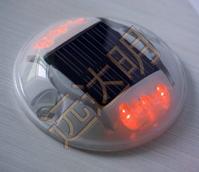
Light pollution is the presence of any unwanted, inappropriate, or excessive artificial lighting. In a descriptive sense, the term light pollution refers to the effects of any poorly implemented lighting sources, during the day or night. Light pollution can be understood not only as a phenomenon resulting from a specific source or kind of pollution, but also as a contributor to the wider, collective impact of various sources of pollution.

Lighting or illumination is the deliberate use of light to achieve practical or aesthetic effects. Lighting includes the use of both artificial light sources like lamps and light fixtures, as well as natural illumination by capturing daylight. Daylighting is sometimes used as the main source of light during daytime in buildings. This can save energy in place of using artificial lighting, which represents a major component of energy consumption in buildings. Proper lighting can enhance task performance, improve the appearance of an area, or have positive psychological effects on occupants.

A flashlight or electric torch, usually shortened to torch, is a portable hand-held electric lamp. Formerly, the light source typically was a miniature incandescent light bulb, but these have been displaced by light-emitting diodes (LEDs) since the early 2000s. A typical flashlight consists of the light source mounted in a reflector, a transparent cover to protect the light source and reflector, a battery, and a switch, all enclosed in a case.
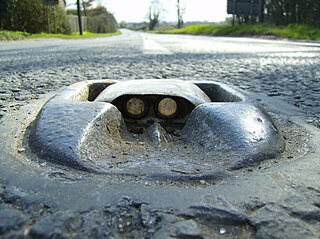
A cat's eye or road stud is a retroreflective safety device used in road marking and was the first of a range of raised pavement markers.

A street light, light pole, lamp pole, lamppost, streetlamp, light standard, or lamp standard is a raised source of light on the edge of a road or path. Similar lights may be found on a railway platform. When urban electric power distribution became ubiquitous in developed countries in the 20th century, lights for urban streets followed, or sometimes led.
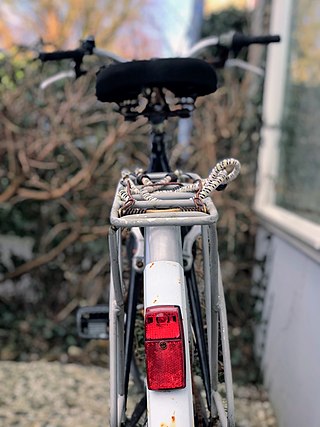
Bicycle lighting is illumination attached to bicycles whose purpose above all is, along with reflectors, to improve the visibility of the bicycle and its rider to other road users under circumstances of poor ambient illumination. A secondary purpose is to illuminate reflective materials such as cat's eyes and traffic signs. A third purpose may be to illuminate the roadway so that the rider can see the way ahead. Serving the latter purposes require much more luminous flux and thus more power.
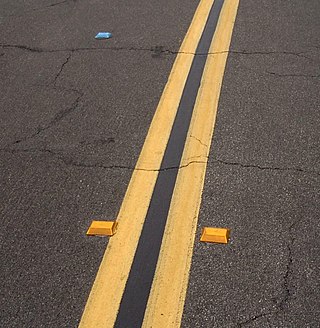
A raised pavement marker is a safety device used on roads. These devices are usually made with plastic, ceramic, thermoplastic paint, glass or occasionally metal, and come in a variety of shapes and colors. Raised reflective markers, such as plastic, ceramic, or metal ones, include a lens or sheeting that enhances their visibility by retroreflecting automotive headlights, while glass road studs gather automotive headlights with a dome shape and reflect the lights with a reflective layer within. Some other names for specific types of raised pavement markers include convex vibration lines, Botts' dots, delineators, cat's eyes, road studs, or road turtles. Sometimes they are simply referred to as "reflectors".

Road surface marking is any kind of device or material that is used on a road surface in order to convey official information; they are commonly placed with road marking machines. They can also be applied in other facilities used by vehicles to mark parking spaces or designate areas for other uses. In some countries and areas, road markings are conceived as horizontal traffic signs, as opposed to vertical traffic signs placed on posts.

A motor vehicle has lighting and signaling devices mounted to or integrated into its front, rear, sides, and, in some cases, top. Various devices have the dual function of illuminating the road ahead for the driver, and making the vehicle visible to others, with indications to them of turning, slowing or stopping, etc., with lights also indicating the size of some large vehicles.

Landscape lighting or garden lighting refers to the use of outdoor illumination of private gardens and public landscapes; for the enhancement and purposes of safety, nighttime aesthetics, accessibility, security, recreation and sports, and social and event uses.

A solar lamp, also known as a solar light or solar lantern, is a lighting system composed of an LED lamp, solar panels, battery, charge controller and there may also be an inverter. The lamp operates on electricity from batteries, charged through the use of a solar photovoltaic panel.

A solar simulator is a device that provides illumination approximating natural sunlight. The purpose of the solar simulator is to provide a controllable indoor test facility under laboratory conditions. It can be used for the testing of any processes or materials that are photosensitive, including solar cells, sun screen, cosmetics, plastics, aerospace materials, skin cancer, bioluminescence, photosynthesis, water treatment, crude-oil degradation, and free radical formation. Solar simulators are used in a wide range of research areas including photobiology, photo-oxidation, photodegradation, photovoltaics, and photocatalysis.
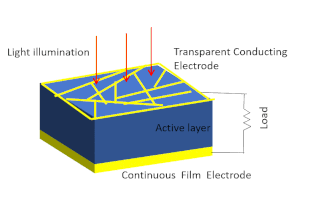
Solar-cell efficiency is the portion of energy in the form of sunlight that can be converted via photovoltaics into electricity by the solar cell.

Solar powered flashlights or solar powered torches are flashlights powered by solar energy stored in rechargeable batteries. Most of these flashlights use light-emitting diodes lamps since they have lower energy consumption compared to incandescent light bulbs.

Solar street lights are raised light sources which are powered by solar panels generally mounted on the lighting structure or integrated into the pole itself. The solar panels charge a rechargeable battery, which powers a fluorescent or LED lamp during the night.
Road traffic control devices are markers, signs and signal devices used to inform, guide and control traffic, including pedestrians, motor vehicle drivers and bicyclists. These devices are usually placed adjacent, over or along the highways, roads, traffic facilities and other public areas that require traffic control.
The following outline is provided as an overview of and topical guide to solar energy:

Cool pavement is a road surface that uses additives to reflect solar radiation unlike conventional dark pavement. Conventional dark pavements contribute to urban heat islands as they absorb 80–95% of sunlight and warm the local air. Cool pavements are made with different materials to increase albedo, thereby reflecting shortwave radiation out of the atmosphere. Increasing albedo reduces heat transfer to the surface and can hypothetically cause local cooling if the spatial scale of the albedo reduction is sufficiently large. The EPA reports "that if pavement reflectance throughout a city were increased from 10 to 35 percent, the air temperature could potentially be reduced by 1°F (0.6°C)." Existing dark pavement can be altered to increase albedo through whitetopping or by adding reflective coats and seals. New pavement can be constructed to increase albedo by using modified mixes, permeable pavements, and vegetated pavements.
There are many practical applications for solar panels or photovoltaics. From the fields of the agricultural industry as a power source for irrigation to its usage in remote health care facilities to refrigerate medical supplies. Other applications include power generation at various scales and attempts to integrate them into homes and public infrastructure. PV modules are used in photovoltaic systems and include a large variety of electrical devices.
Light poverty is the state or condition in which people or communities lack artificial or electric light after sunset. This originates from many social and economic reasons, including inability to afford efficient lighting. Light poverty may also occur when a country's national grid has not electrified rural areas requiring light. As of 2019, 1.1 billion people do not have access to light, and this has many social and economic consequences, such as children being unable to study and rural markets and businesses being unable to operate due to the lack of visibility.
